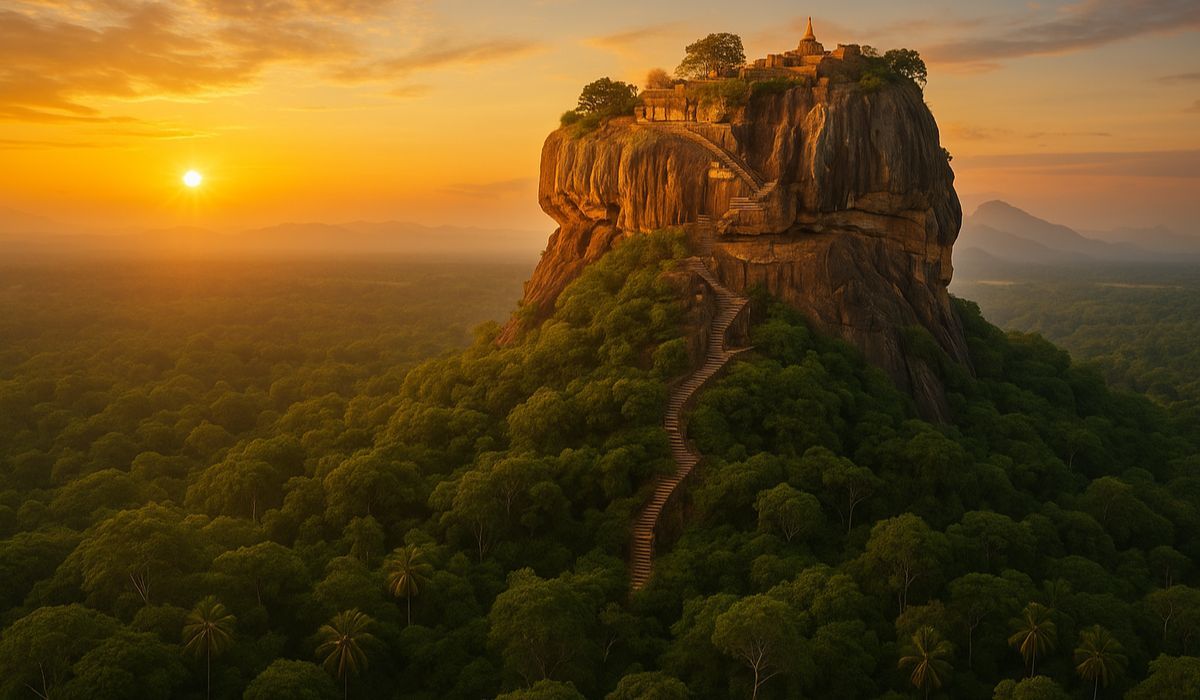Sri Lanka Travel Guide: known as the “Pearl of the Indian Ocean,” is a teardrop-shaped island nation that packs incredible diversity into a compact area smaller than Ireland. This enchanting destination captivates travellers with its ancient Buddhist temples, mist-covered tea plantations, abundant wildlife, pristine beaches, and warm hospitality that has welcomed visitors for over 2,000 years.
Sri Lanka Travel Guide
Sri Lanka Travel Guide: offers extraordinary value for travellers seeking authentic cultural experiences, natural beauty, and adventure without breaking the bank. The island’s rich history spans over 2,500 years, creating a living museum where ancient temples, colonial architecture, and modern Sri Lankan culture coexist harmoniously.
Wildlife enthusiasts discover one of the world’s highest densities of leopards, along with elephants, whales, and hundreds of bird species in compact national parks. Tea lovers explore the world’s finest Ceylon tea gardens in the cool hill country, while beach lovers enjoy both calm west coast waters and surfing waves on the east coast.
The Sri Lankan people’s genuine warmth and Buddhist philosophy of kindness create an atmosphere of peace and welcome that leaves lasting impressions on visitors. Combined with incredibly affordable prices, delicious cuisine, and diverse landscapes, Sri Lanka delivers unforgettable experiences that rival destinations costing twice as much.
Ancient Cultural Triangle
Sigiriya Rock Fortress
Sri Lanka Travel Guide: Sigiriya stands as Sri Lanka’s most iconic attraction – a massive rock rising 200 meters from the jungle floor, crowned with the ruins of an ancient palace. The 5th-century fortress features remarkable engineering, including the famous Mirror Wall and stunning frescoes of celestial maidens that have survived centuries of weather.
The climb to the summit rewards visitors with panoramic views of the surrounding countryside and insights into ancient Sri Lankan civilisation that UNESCO recognises as a World Heritage masterpiece.
Anuradhapura Sacred City
Anuradhapura served as Sri Lanka’s first capital for over 1,000 years and remains one of Buddhism’s most sacred sites. The ancient city houses the Sri Maha Bodhi Tree, grown from a cutting of the original Bodhi Tree under which Buddha attained enlightenment.
Massive dagobas (stupas), ancient monasteries, and intricate stone carvings create a spiritual atmosphere where pilgrims and visitors experience the depth of Sri Lankan Buddhist heritage that continues to influence daily life across the island.
Polonnaruwa Medieval Capital
Sri Lanka Travel Guide: Polonnaruwa showcases the golden age of Sri Lankan civilisation through remarkably preserved temples, palaces, and the famous Gal Vihara rock temple featuring four magnificent Buddha statues carved from a single granite wall.
Hill Country and Tea Culture
Kandy Cultural Heart
Sri Lanka Travel Guide: Kandy, the last royal capital, centres around the sacred Temple of the Tooth Relic, Buddhism’s most important shrine, housing a tooth of the Buddha. The city’s colonial architecture, botanical gardens, and traditional Kandyan dancing performances provide insights into Sri Lankan culture.
The daily temple ceremonies and the famous Esala Perahera festival showcase the living traditions that make Sri Lanka’s heritage more than just historical monuments.
Tea Country Experience
The central hill country transforms Sri Lanka into a completely different landscape of rolling green tea estates, colonial-era bungalows, and cool mountain air. Nuwara Eliya, known as “Little England,” offers visitors the chance to tour tea factories, learn the tea-making process, and stay in converted plantation houses.
Train journeys through tea country provide some of the world’s most scenic rail experiences, winding through mountains, valleys, and countless tea gardens where Tamil workers continue traditions established during British colonial times.
Wildlife and National Parks
Sri Lanka Travel Guide: national parks offer incredible wildlife viewing in relatively small areas. Yala National Park provides the world’s highest density of leopards, along with elephants, sloth bears, and over 200 bird species in diverse habitats from beaches to dry forests.
Udawalawe National Park specialises in elephant watching, while Minneriya National Park hosts “The Gathering” – hundreds of elephants congregating around ancient reservoirs during the dry season, creating one of Asia’s greatest wildlife spectacles.
Whale watching from Mirissa offers encounters with blue whales, sperm whales, and dolphins in the deep waters off Sri Lanka’s southern coast, making the island one of the world’s best cetacean viewing destinations.
Beaches and Coastal Experiences
Sri Lanka Travel Guide: coastline provides year-round beach experiences on different sides of the island. The west and south coasts (Negombo, Hikkaduwa, Unawatuna, Mirissa) offer calm waters and beautiful sunsets from November to April.
The east coast (Arugam Bay, Trincomalee) provides excellent surfing conditions and pristine beaches from May to September, allowing visitors to enjoy perfect beach weather regardless of travel dates.
Traditional stilt fishermen near Galle create iconic images, while the Dutch colonial fort in Galle provides historical context to the island’s maritime heritage.
Delicious Sri Lankan Cuisine
Sri Lankan cuisine combines Indian spices with local ingredients and cooking techniques, creating unique flavours that reflect the island’s cultural diversity. Rice and curry form the foundation of most meals, with coconut, chilli, and aromatic spices creating complex flavour profiles.
Must-Try Dishes:
- Rice and Curry: Multiple curries served with rice, creating balanced meals with varying flavours and spice levels
- Hoppers: Bowl-shaped pancakes perfect for breakfast or dinner
- Kottu Roti: Chopped flatbread stir-fried with vegetables, eggs, and meat
- Ceylon Tea: World-renowned tea served strong and sweet
Practical Travel Information
Best Time to Visit: Sri Lanka’s dual monsoon system means some part of the island always enjoys good weather. West/South coasts are best November-April, while the East coast is perfect May-September.
Budget: Sri Lanka offers exceptional value with budget travellers managing on $20-30 daily, while mid-range comfort costs $40-60 per day. Luxury experiences remain affordable compared to other destinations.
Transportation: Trains provide scenic journeys and cultural experiences, while buses reach every destination cheaply. Taxis and tuk-tuks offer convenient short-distance travel.
Language: Sinhala and Tamil are the official languages, but English is widely spoken in tourist areas.
Essential Travel Tips
Plan your route according to monsoon patterns to maximise good weather. Book accommodations in advance during peak season (December-March) in popular areas.
Respect Buddhist customs by covering shoulders and legs when visiting temples, and removing shoes before entering sacred areas. Always walk clockwise around Buddhist monuments.
Try local transportation methods for authentic experiences, but prioritise safety on mountain roads. Consider hiring guides for cultural sites to gain deeper insights into Sri Lankan history and traditions.
Sri Lanka delivers incredible diversity, authentic cultural experiences, and natural beauty at prices that make luxury accessible to most travellers, creating memories that last a lifetime in this enchanting island paradise.


